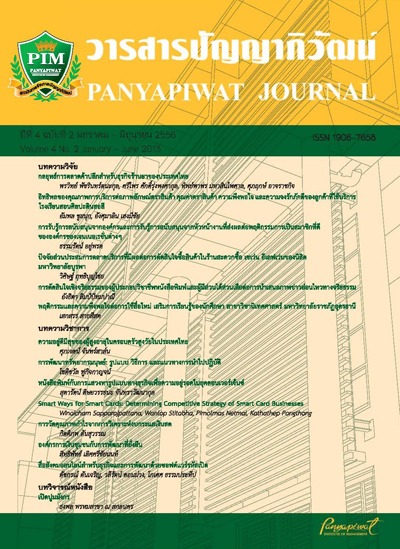SMART WAYS FOR SMART CARDS: DETERMINING COMPETITIVE STRATEGY OF SMART CARD BUSINESSES
Main Article Content
บทคัดย่อ
Smart card is a plastic card which stores financial value and is adopted to replace some cash amount in daily consumption. The smart card can be regarded as a financial product making the card holders conveniently spends his or her cashed value and, at the same time, it can be taken as marketing promotion tool for building up customer loyalty to the card issuer and its allied merchant partners. Developing strategic directions begins when the card issuer determines right market and competitive positioning. Who is a real customer? Who are all rivalries? This article is giving a potential response, based on our recent research, to these questions so that a profitability of the issuing partners can be sustained.
สมาร์ทการ์ด คือ บัตรพลาสติกที่เก็บมูลค่าของเงินและสามารถใช้แทนเงินสด จัดว่าเป็นผลิตภัณฑ์ทางการเงินที่เพิ่มความสะดวกและความปลอดภัยให้กับผู้ถือบัตรได้ และยังจัดเป็นเครื่องมือทางการตลาดในการสร้างความภักดีต่อผู้ออกบัตรและคู่ค้าที่รับบัตร ดังนั้นในการวางแผนกลยุทธ์ให้กับธุรกิจสมาร์ทการ์ด จึงจำเป็นต้องกำหนดตำแหน่งทางการตลาดให้ชัดเจน เพราะจะมีผลต่อการกำหนดบริบทของการแข่งขัน กล่าวคือ ใครเป็นลูกค้าและใครคือคู่แข่ง ซึ่งทำให้เราทราบว่าความสำเร็จในการสร้างผลกำไรในระยะยาวนั้น เกิดจากปัจจัยอะไรบ้าง บทความนี้นำผลการวิจัยเกี่ยวกับพฤติกรรมการใช้สมาร์ทการ์ดมาต่อยอดธุรกิจ เพื่อแสวงหาหนทางในการสร้างความเติบโตให้ธุรกิจสมาร์ทการ์ดได้อย่างยั่งยืน
Article Details
“ข้าพเจ้าและผู้เขียนร่วม (ถ้ามี) ขอรับรองว่า บทความที่เสนอมานี้ยังไม่เคยได้รับการตีพิมพ์และไม่ได้อยู่ระหว่างกระบวนการพิจารณาลงตีพิมพ์ในวารสารหรือแหล่งเผยแพร่อื่นใด ข้าพเจ้าและผู้เขียนร่วมยอมรับหลักเกณฑ์การพิจารณาต้นฉบับ ทั้งยินยอมให้กองบรรณาธิการมีสิทธิ์พิจารณาและตรวจแก้ต้นฉบับได้ตามที่เห็นสมควร พร้อมนี้ขอมอบลิขสิทธิ์บทความที่ได้รับการตีพิมพ์ให้แก่สถาบันการจัดการปัญญาภิวัฒน์หากมีการฟ้องร้องเรื่องการละเมิดลิขสิทธิ์เกี่ยวกับภาพ กราฟ ข้อความส่วนใดส่วนหนึ่งและ/หรือข้อคิดเห็นที่ปรากฏในบทความข้าพเจ้าและผู้เขียนร่วมยินยอมรับผิดชอบแต่เพียงฝ่ายเดียว”
References
Abcede, Angel. (1996). Payment Options Surpass Credit Debit Boundaries. NPA, National Petroleum News. July.
Baumeister, Roy F. and Brad J. Bushman. (2008). Social Psychology and Human Nature. CA:Thomson Wadsworth.
Burns, G.S., Chappelow, J., Zink, C.F., Pagnoni, G., Martim-Skurski, M.E., and J. Richard. (2005).Neurobiological Correlates of Social Conformity and Independence during Mental Rotation.
Biological Psychiatry Review, April. Cialdini, Robert. (2001). Influence: Science and Practice, 4th ed. Boston: Allyn & Bacon.
Creswell, J.W. (2009). Research Design, 3rd ed. California, USA: SAGE Publications.
Festinger, L. (1954). A Theory of Social Comparison Process. Human Relations, July.
Doug, Manchester. (1997). Smart Card: Key to Cashless Economy?, The Futurist. Jan/Feb.
Douglas A. Mudd. (2007). Getting Paid: Plastic Cash, A History of Money and Credit Card in
America. Credit Control, 28(3).
Drucker, P.F. (1986). Innovation and Entrepreneurship. NY: HarperBusiness.
Evans, Martin, Ahmad Jamal and Gorgon Foxall. (2006). Consumer Behavi John Wiley & Sons Inc.
Gosnell, Davdi. (2004). Anchors Aweigh For Debit, Credit Card Management. September.
La-or Kovavisarach and Puchapan Laochan. (2008). Consumer Behaviors in Choosing SmartPurse:
ase Study on 7-Eleven Store, a proceeding at the gth Conference on Supply Chain and Logistics Management, 20th-22nd November.
Kubtawintu, Tera. (1996). Design a Front Office System for Electronic Banking, a Master's thesis for Mahidol University.
Kulaya Saksalakul. (2006). Using Digital Cash-card in Convenient Store. Bangkok: Thamasat University.
Macionis, John J. (2009). Sociology. 13th ed. NJ: Pearson Education.
McCarthy, E.J. (1977). Basic Marketing Learning Aid. Illinois: Homewood.
Mellow, John P. Jr. (1995). The Future of Cash. CFO's Special Report on Economic Commerce.December.
Orr . Bill. (1998). The Great Card Question: Will It Be Smart, American Banker Association. ABA Banking Journal. September.
Plouffe, Christopher R., Vandenbosch, Mark and Hulland. (2001). Intermediating Technology and Multi-group Adoption: A Comparison of Consumer and Merchant Adoption Intentions toward a new Electronic Payment System. Journal of Product Innovation Management. 18.
Quester, Pascale et al., (2007). Consumer behavior: Implications for Marketing Strategy.New South Wales: McGraw-Hill.
Rakkiat Jiranthorn, Narongsak Sighapaiboonporn, Patraporn Nguadulayawatta, Siwaporn Kangalasuk and Sriwimol Mahathanobol. (2007). Factors Affecting Consumer's Buying Decision on Food Supplement in Hadyai. Prince of Songkla's Journal. 13(2) April-June.
Roger, E.M. and Shoemaker, F. (1971). Communication of New Innovation. New York: Macmillan.
Roger, Everett M. (1995). Diffusion of Innovations. 4th ed. New York: Free Press .
Sapparojpattana, Winaicharn; Netramai, Pimolmas; Sthitabha, Wanlop and Pongthong, Kathathep.(2012). Factors Influencing Smart-card Adoptions in Retail Consumption, a proceeding in the 3rd International Conference on Information and Communication Technology for Embedded Systems (ICISTES), Bangkok, Thailand, 22nd – 24th March.
Solomon, Michael. R., (2007) Consumer Behavior: Buying Having and Being. New Jersey: Pearson Prentice Hall.
Taherdoost, Hamed; Sahibuddin, Shamsul; Namayandeh, Meysam; Jalaliyoon, Neda; Kalantari,Alaeddin, and Chaeikar, Saman Shojae. (2012). Smart Card Adoption Model: Social and Ethical Perspectives. International Journal of Research and Reviews in Computer Science,3(4) (August), 1792 - 1795.
Taherdoost, Hamed; Sahibuddin, Shamsul; and Jalaliyoon, Neda. (2011). Smart Card Security,Technology and Adoption. International Journal of Security, 5(2), 74-84.
Taneja, Sunil. (1999). The Payment Evolution: Customer Service Through Flexibility at the Point of Sale. Chain Store Age. September.
Teddie, C. and Tashakkori, A. (2009). Foundations of Mixed Methods Research. California, USA: SAGE Publications.
Thonchai Santiwong. Satisfaction and Measuring Satisfaction. Retrieved October 30, 2009, from
www.surinareal.go.th [30 October 2009.]
Van Hove, Leo. (2001). The New York City Smart Card Trial in Perspective: A Research Note.International Journal of Electronic Commerce. 5(2), 119-131.
Winaicharn Sapparojpattana, Wanlop Sthitabha, Pimolmas Netramai, and Kathathep Pongthong.(2011). Social and Individual Factors Influencing Acceptance of Innovation and Adoption Behaviors for SmartCard. Bangkok : Panyapiwat Institute of Management.
Yang, Bill Z. (2007) What is (Not) Money? Medium of Exchange + Means of Payment. American Economist. 51(2).

